 |
|
Focus features two in-depth reviews each month of fine art, architecture and design exhibitions and events at art museums, galleries and alternative spaces around Japan. The contributors are non-Japanese art critics living in Japan.
|
|
|
 |
 |
 |
Lost in Odaiba: The K-Museum's Postmodern Delight
Michael Pronko |
 |
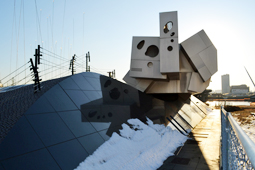 |
|
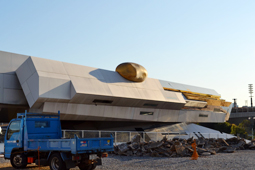 |
| Light and dark, sunlight and shadow play off each other around the K-Museum. |
|
A large organic gold blob contrasts with the sharp angles beneath. Chunks of concrete dug up from the nearby lot seem almost a part of the plan.
|
Set in a once-abandoned, now-rebuilding area of Tokyo, the K-Museum is a rousing, delightful structure that is about as postmodern as a building gets. Its inner museum space lies dormant, but as a piece of architecture that is almost a sculpture, its captivating design and unusual nature draw in viewers and set them pondering.
The building was designed by uncompromising architect Makoto Sei Watanabe, the architect for several museum, corporate, and university structures throughout the country. The K-Museum was completed in 1996 as part of the first wave of construction in the newly developing "Tokyo Waterfront City," Odaiba, located on an artificial island at the head of Tokyo Bay. The museum's interior was designed to make visible the vast, invisible networks of energy, information, utilities, and refuse that keep Tokyo working.
However, when the economic bubble burst, the museum closed without ever fully achieving its purpose of housing exhibits about the urban infrastructure of Tokyo. The building was left stranded in the middle of abandoned fields, unfinished walkways and bankrupt developments.
Now, however, the area is coming back and the time would seem right for the museum to once again be opened up, the fences taken down and the unique edifice to get more notice. The photogenic exterior begs for attention. The external contours and reflective surfaces serve as a mirror to let us reconsider what a building can be.
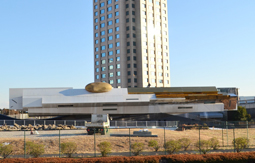 |
|
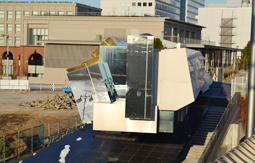 |
The balance of the building gives it lightness and a sense of motion, as if it were ready to launch into the water to the right. Behind, another new building is added to the waterfront development project.
|
|
Silver front pieces reflect the water and sunlight nearby, borrowing images and distorting them into new patterns. |
The exterior is a textural exploration in opposites. Rough black rubber is set against springy wires and bouncy poles. The light-absorbing materials contrast with the reflective metal surfaces, which contrast again with the base of thick, black granite that both absorbs and reflects light. Polished, molded, poured, these different textures bring together diverse methods of construction. Like Tokyo, wherever you look and whatever you see, you see its opposite as well.
The building also works powerfully with light. Set in a wide-open area by a pedestrian bridge, a broad waterway and an empty lot being surveyed for construction, the structure is bathed in sunlight. In that sense it departs from Tokyo's typical ambience of shadows and interior spaces. Light plays off the surface of the black granite, is absorbed by the stone, and is again reflected in the shiny metal blocks poking out toward the water.
The contrasts and variations from each angle create a tantalizing visual experience. Like a Japanese rock garden, every view reveals a different combination of elements interacting. From one angle, you get stone and rubber, from another, shiny metal and a hint of granite; and from yet another the reflections of light, water, nearby buildings and sky leap out, shifting with each motion of the viewer.
The balance of the structure is also part of its impact. Poised delicately, as if casually dropped there and ready to be picked up and moved again, the K-Museum plays with notions of permanence and transience. It feels anchored, yet still afloat, like some bankside barge or houseboat tied up temporarily, waiting. The two disparate ends of the building present a teeter-totter sense of motion, pointing toward the water but leaning toward the land -- the perfect waterfront structure.
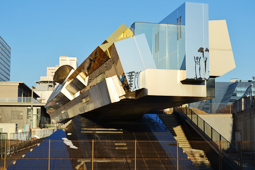 |
|
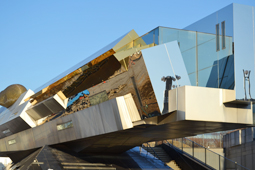 |
| The assertive side of the structure piles angle upon angle in a tense standoff of surfaces, shapes and directions, much like Tokyo itself. |
|
The reflections of surrounding objects, spaces and light seem to subvert the usual relationships of subject to object, foreground to background, giving the building a constantly changing exterior.
All photos by Michael Pronko
|
The site is less isolated than it once was as more office buildings, condominiums, small museums, and a university satellite campus gradually start filling in the once-empty lots of the waterfront. The building is intensely urban, yet still feels at home with the open fields, huge canals and landscaped greenery.
The newly built pedestrian bridges that flank the K-Museum are large and wide enough to provide numerous viewing points. Lovers on a walk, families out for a stroll, and shoppers clutching bags all stop when they notice the structure, mulling over, perhaps, the questions it poses.
The waterfront developers should open the building, develop it, and let people inside to see one of the area's most intriguing sites. Sadly, it hardly appears on many of the area's walking maps. Hopefully, as the waterfront area continues to develop, the fence surrounding the building will be taken down, so people can touch and explore up close the textures, contrasts and appeal of this postmodern gem.
The sadness of being ignored ironically resembles the fate of the old wooden buildings one often sees in Tokyo that seem to resist change and valiantly cling to the past; only the K-Museum clings to the future with its startling, challenging architectural design. The structure incorporates Tokyo's essential character and refurbishes it for re-presentation. Standing like the inverse of a museum, it poses a question: could the real museum be Tokyo itself, and buildings like this one the masterpieces inside?
 |
 |
Michael Pronko
Michael Pronko teaches American literature, film, art and music at Meiji Gakuin University. He has appeared on NHK, Sekai Ichiban Uketai Jugyo, and other TV programs. His publications include several textbooks and three collections of essays about Tokyo. He writes regular columns for Newsweek Japan, ST Shukan, The Japan Times, and for his own websites, Jazz in Japan and Essays on English in Japan. |
|
 |
|